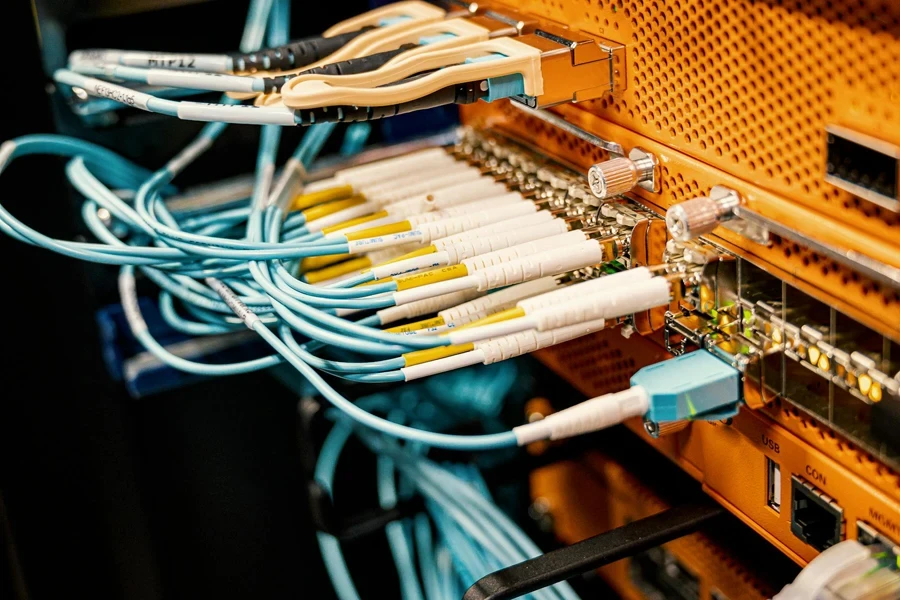Table of Contents
• Introduction
• Market Overview
• Types and features of network hubs
• Things to consider when choosing network hubs
• Conclusion
Introduction
Network hubs serve as pivotal devices in computer networks, connecting multiple devices to facilitate seamless data communication. Operating at the Physical Layer of the OSI model, they are essential for establishing straightforward, small-scale networks. These hubs are especially valuable in business environments where cost-effective and efficient network management is crucial. By understanding their market trends and features, businesses can make informed decisions to enhance their network infrastructure. Despite their simplicity, network hubs remain a fundamental component in modern networking solutions.
Market overview

Current trends
The global network management system market, encompassing network hubs, was valued at $9.3 billion in 2022 and is forecasted to reach $14.6 billion by 2027, with a CAGR of 9.4%. According to MarketsandMarkets, key drivers for this growth include the rise of Software-Defined Networking (SDN), which offers new automation opportunities in network management, and the increasing need for comprehensive network visibility. Furthermore, the demand for optimizing business operations continues to fuel the market.
Main drivers
Small and Medium-sized Enterprises (SMEs) are adopting technologies such as cloud computing, artificial intelligence, and the Internet of Things (IoT) to enhance business productivity. These advancements necessitate robust network management solutions to handle evolving network infrastructures effectively. Despite these drivers, the market faces challenges such as the availability of free network management tools and high deployment and upgrade costs. However, the need for improved network performance, reduced IT complexities, and streamlined business processes is expected to sustain market growth.
Market share
Regionally, North America dominates the market due to rapid technological advancements and substantial investments in IT infrastructure. Enterprises and service providers in this region continuously upgrade their network infrastructure to integrate advanced technologies, thereby driving demand for network management solutions. This trend is expected to persist, with significant growth anticipated across various sectors, including BFSI, IT and telecom, government, manufacturing, healthcare, retail, and transportation, according to MarketsandMarkets.
Types and features of network hubs
Network hubs are critical components in computer networks, facilitating data communication by connecting multiple devices. Operating at the Physical Layer of the OSI model, they come in three main types, each with distinct features and functionalities:

Passive hubs
Passive hubs relay data without amplification, making them suitable for basic network setups. These hubs operate without an external power source, drawing power from connected devices. Passive hubs do not improve signal quality, limiting their use to small networks where signal strength is not a concern. They typically feature a simple design with 4-12 ports and operate in half-duplex mode, allowing data transmission in only one direction at a time. This can lead to data collisions if multiple devices transmit simultaneously.
Active hubs
Active hubs amplify and clean incoming signals before rebroadcasting them, enhancing signal strength and quality. These hubs have their own power supply and can act as repeaters, extending the network’s operational range. Active hubs typically include retiming and resynchronization capabilities, ensuring clear data transmission over longer distances. They also maintain one collision domain across all ports, which can handle moderate traffic loads efficiently. Active hubs are ideal for larger networks requiring reliable signal transmission over extended distances.
Intelligent hubs
Intelligent hubs combine the features of active hubs with advanced management capabilities. They offer remote management and flexible data rate adjustments, providing enhanced control over network traffic. Intelligent hubs can monitor network performance, diagnose issues, and optimize data flow, making them suitable for complex environments. They often support additional features such as virtual LANs (VLANs) and spanning tree protocols, which help in managing network paths and reducing data collisions. These hubs typically have a higher port count, ranging from 12 to 24 ports, and support full-duplex transmission, allowing simultaneous data transmission in both directions.
Key technical features
Signal amplification and cleaning: Active and intelligent hubs include signal amplification and retiming capabilities to ensure data integrity over long distances.
Collision domain management: Intelligent hubs can create multiple collision domains, reducing the likelihood of data collisions and improving network efficiency.
Port density: Hubs typically offer between 4 to 24 ports, with intelligent hubs providing higher port densities to accommodate more devices.
Power-over-Ethernet (PoE): Some hubs, particularly intelligent ones, may offer PoE capabilities, enabling them to power devices such as IP cameras and wireless access points directly through the Ethernet cable.
Management capabilities: Intelligent hubs feature remote management interfaces, allowing administrators to monitor and configure the network remotely. These hubs support SNMP (Simple Network Management Protocol) for effective network management.
Things to consider when choosing network hubs
Network size and scale

The number of devices to be connected and the required port count are fundamental considerations. Small networks may be adequately served by hubs with 4 to 8 ports, while larger networks often necessitate hubs with 12 to 24 ports. Passive hubs are appropriate for smaller, basic networks, whereas active or intelligent hubs are preferable for larger setups that demand more ports and superior signal management.
Signal amplification needs
Determining the need for signal amplification is essential. Passive hubs relay signals without amplification, making them suitable for limited, short-range applications. Active hubs, on the other hand, amplify and clean incoming signals, extending network distances and improving signal clarity. Intelligent hubs not only amplify signals but also offer advanced management features and flexible data rates, which are critical for complex networks requiring robust signal processing and high data throughput.
Cost and budget
Budget constraints play a significant role in the selection process. Passive hubs are generally the most cost-effective, offering basic connectivity without additional features. Active hubs, which provide enhanced signal quality and extended range, come at a higher price point. Intelligent hubs, equipped with advanced management capabilities and remote configuration options, represent the highest investment. Despite their cost, intelligent hubs can deliver significant value through improved network performance and manageability.
Environment
The deployment environment must be carefully considered. In scenarios where network devices require power through Ethernet cables, hubs with Power-over-Ethernet (PoE) capabilities are indispensable. Additionally, for networks operating in harsh or extreme conditions, selecting ruggedized hubs designed to withstand such environments is crucial. Features like PoE support and environmental hardening ensure network reliability and resilience in diverse settings.
Management features
Advanced management features are a critical aspect of modern network hubs. Intelligent hubs often include remote management interfaces, allowing for centralized monitoring and configuration. This capability is particularly beneficial for large, distributed networks where on-site management is impractical. Support for SNMP (Simple Network Management Protocol) and other management protocols can enhance oversight, allowing for real-time performance monitoring, issue diagnosis, and configuration management.
Conclusion

Network hubs are crucial components in various networking setups, especially for small and straightforward networks. Understanding their types, features, and current market trends is essential for making informed decisions that enhance network performance. For B2B resellers, selecting the right network hub can significantly impact network efficiency and reliability. By considering factors such as network size, signal amplification needs, cost, environment, and management features, resellers can provide clients with tailored solutions that support their specific operational requirements. Informed choices in network hubs lead to cost-effective, scalable, and robust networking solutions, ultimately contributing to improved business operations and customer satisfaction.




